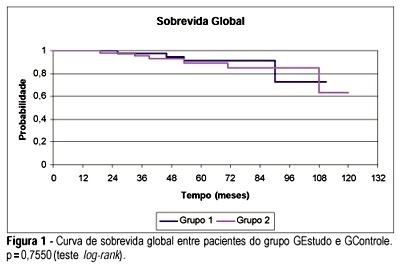Summary
Revista Brasileira de Ginecologia e Obstetrícia. 2000;22(6):339-345
DOI 10.1590/S0100-72032000000600004
Purpose: to quantify the vessels and epithelial proliferation, applying immunohistochemical staining with anti-CD34 as well as anti-PCNA markers, in intra-epithelial neoplasia of the uterine cervix. Methods: in the present study, 16 patients with CIN III, 16 with CIN II, 21 with CIN I and 11 with normal cervix (control group) were investigated. Slide analysis was performed at the same time by two observers, in 10 consecutive sites using 100X and 400X magnification, both in the highest vascularization (CD34) and proliferative activity sites (PCNA). Results: the means obtained with the use of anti-PCNA in intraepithelial neoplasias were: 78.2% (CIN III), 52.1% (CIN II), 33.3% (CIN I) and 4.6% (control group), while 199.1 vessels (CIN III), 162.0 vessels (CIN II), 111.7 vessels (CIN I) and 124.4 vessels (control group) were quantified using anti-CD34 as a vascular marker. Conclusion: the results showed that both markers, anti-PCNA and anti-CD34, are useful for investigating proliferative and angiogenic activity, respectively. However, anti-PCNA showed better and more accurate results than anti-CD34 in differentiating intraepithelial neoplasias.
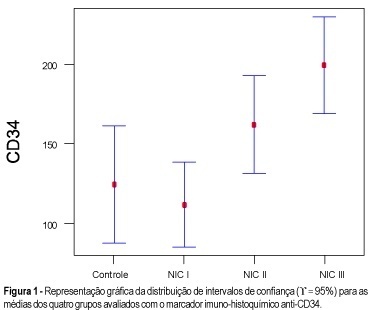
Summary
Revista Brasileira de Ginecologia e Obstetrícia. 2000;22(6):347-351
DOI 10.1590/S0100-72032000000600005
Purpose: to analyze the symptoms of premenstrual syndrome (PMS), its duration, time of presentation and pathogenesis. Methods: a questionnaire was applied to 254 women aged 20 to 44 years, without gynecological or clinical conditions affecting their general state or physical well-being, excluding those with amenorreha for more than six months, hysterectomized or pregnant. Results: one hundred and ten women (43.3%) describing at least one intense symptom causing harm to their life, were considered as having PMS. Irritability was presented by 86.4%, tiredness by 70.9%, depression by 61.8%, headache by 61.8%, breast tenderness by 59.1% and abdominal pain by 54.5%. Almost all (94.5%) had more that one symptom, 89.1% presented psychological complaints, and 76.4% associated physical and psychological complaints. Most declared that duration of the symptoms was three to four days (32.4%) or five to seven days (31.4%). Conclusions: the clinical picture of PMS is generally composed of irritability and/or depression, associated with tiredness and headache or breast pain, there being association of physical and psychological symptoms, for 3 to 7 days, and it is difficult to attribute a single etiology to it at this stage of knowledge.
Summary
Revista Brasileira de Ginecologia e Obstetrícia. 2000;22(6):353-363
DOI 10.1590/S0100-72032000000600006
Purpose: to study the prognostic parameters for perinatal death in pregnancies with absent or reversed end-diastolic flow velocity on umbilical artery dopplervelocimetry. Methods: two hundred and four pregnancies were retrospectively reviewed. The methods used were cardiotocography, fetal biophysical profile, amniotic fluid index and dopplervelocimetry of ductus venosus, fetal aorta, middle cerebral artery, umbilical arteries and uterine artery. The logistic regression model was applied to one hundred and seventy cases in order to determine the most accurate variable for predicting perinatal death. Results: the mortality rates were: 28 cases of intrauterine fetal death (13.7%) and 45 neonatal deaths (22.1%). A statistically significant correlation was found between death and the studied variables. The perinatal death rate in the group with birth weight below 1,000 g was 74.7%, and in the group with gestational age at delivery below 31 weeks it was 66.3%. By logistic regression, birth weight was the most accurate variable for predicting perinatal death, and a probability curve for death according to this variable was obtained. Conclusions: absent or reversed end-diastolic flow velocity in the umbilical arteries is a severe fetal condition, where the risk of perinatal death is mainly related to birth weight and a gestational age at delivery below 31 weeks.
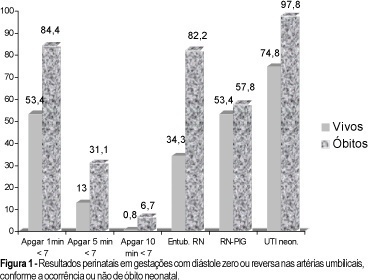
Summary
Revista Brasileira de Ginecologia e Obstetrícia. 2000;22(6):365-371
DOI 10.1590/S0100-72032000000600007
Purpose: to evaluate the accuracy of prenatal ultrasound in the diagnosis of nephrouropathies. Methods: the authors followed-up 127 pregnancies referred to the Fetal Medicine Center of UFMG with suspicion of these anomalies. Fetal biometry, growth, vitality, and associated malformations were evaluated. Finally, a detailed description of the renal system was made to define the prenatal morphologic diagnosis of the malformations to be compared with the postnatal diagnosis. Results: based on the kappa index (statistical method that measures the concordance between different measurements, methods or measurement instruments: below 0.40, poor agreement; between 0.40 and 0.75, good agreement; above 0.75, excellent ageement), the authors found an excellent concordance (kappa index 0.95). Among the 127 cases, there were only 9 misdiagnoses, all of them of obstructive uropathies: 6 cases showed different obstruction levels after delivery and in three cases there were confounding diagnosis with multicystic kidney. Conclusions: the detailed ultrasonographic description of the renal system is a good method for prenatal diagnosis of the fetal nephropathies, allowing some options to modify the outcome of these fetuses, like to send them to specialized centers, to anticipate delivery and even to apply intrauterine therapy, in order to preserve the renal function. Serial echography and amnioinfusion can be used to improve the precision of prenatal diagnosis.
Summary
Revista Brasileira de Ginecologia e Obstetrícia. 2000;22(6):373-380
DOI 10.1590/S0100-72032000000600008
Purpose: to construct a b-human chorionic gonadotropin (b-hCG) regression curve following complete hydatidiform mole (CHM) of patients with spontaneous remission, and then compare it to that of CHM patients with gestational trophoblastic tumor (GTT). Also, to compare the b-hCG regression curve of CHM patients followed-up at the Service to the regression curve of other authors1-3. Methods: clinical and laboratory evaluations (serum determinations of b-hCG) were performed on admission and during post-molar follow-up of CHM patients treated at the University Hospital of Botucatu between 1990 and 1998. The result of the serial b-hCG determinations was analyzed using log regression curves. The evolution of the b-hCG regression curve was analyzed and compared between cases of CHM with spontaneous remission and with GTT using a log regression curve, with 95% confidence interval. The log regression curve of the spontaneous remission group was compared to those of other authors1,2. Individual log curves for each patient were constructed and classified according to the four curve types (I, II, III, and IV) proposed by Goldstein³ for post-molar follow-up. Results: sixty-one patients received complete post-molar follow-up, 50 (82%) showing spontaneous remission and 11 (18%) developing GTT. In the group of patients with CHM and spontaneous remission, the time to return to normal b-hCG levels after mole emptying was 20 weeks. The patients who developed GTT showed early deviation from normal b-hCG regression curve 4 to 6 weeks after mole emptying. These patients received chemotherapy normally starting during the 9th post-mole emptying week. Conclusions: the regression curve of post-CHM b-hCG in patients with spontaneous remission showed a log-exponential decline similar to that observed by other authors1,2, but different from that of CHM patients who developed GTT. Three types of b-hCG regression curves similar to Goldstein's³, I, II, and IV, were identified, as well as two other different types: V (normal regression) and VI (abnormal regression).
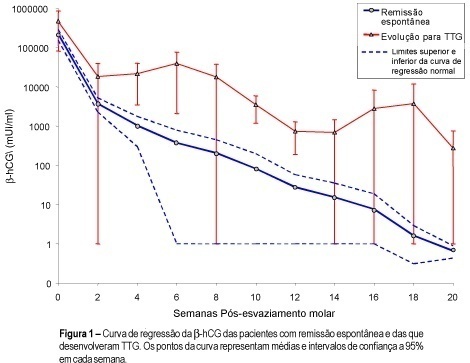
Summary
Revista Brasileira de Ginecologia e Obstetrícia. 2003;25(6):389-395
DOI 10.1590/S0100-72032003000600002
PURPOSE: to evaluate acceptability, adhesion and experience with the use of female condom (FC) among HIV-infected women. METHODS: prospective descriptive study with 76 HIV-infected women under care at CAISM/UNICAMP and Centro Corsini, both in Campinas. After a screening interview and agreeing to participate, the volunteers received a diary to register their intercourses and correspondent use of male condom (MC). After 30 days, they returned to a training visit when the FC was inserted in a pelvic model, also bringing their diary related to the previous cycle, considered a control cycle. A structured questionnaire was used at 30, 60 and 90 days, also with the respective diary on sexual intercourse and use of MC and FC kept for posterior data entry. c², Fisher's exact, McNemar and Friedman tests were applied statistical analysis of paired samples. RESULTS: there was a predominance of young women, with low schooling, living with their partner. Rate of continuity was 52% after 90 days. The use of FC in half the intercourses for each time period remained stable over the 90-day interval. There was a significant reduction in unprotected intercourses (from 14 to 6%), without use of FC or MC, at the end of the period. The initial difficulties in handling the device were overcome. Serodiscordant couples had more protected intercourses than concordant couples, but the difference did not reach statistical significance. Women reporting consistent previous use of MC had more protected sex using FC. CONCLUSIONS: the offer of the female condom was able to reduce unprotected intercourses in HIV-infected women, which were highly motivated and receptive for the new method.
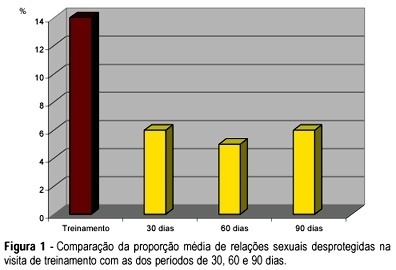
Summary
Revista Brasileira de Ginecologia e Obstetrícia. 2003;25(6):396-401
DOI 10.1590/S0100-72032003000600003
PURPOSE: to evaluate the significance of neoangiogenesis for the prognosis of endometrial carcinoma, by quantifying and comparing the vessels with the grade of histologic differentiation and tumor staging. METHODS: the 56 studied cases consisted of 11 atrophic endometria, 10 proliferative endometria, 10 GI, 13 GII and 12 GIII adenocarcinomas. Two histologic sections were obtained for each case: one was stained with hematoxylin-eosin and the other was sent for a immunohistochemical study with anti-CD34. The utilized histometric method was vessel counting at the tumoral growth interface with the adjacent stroma, and in the control group, at the endometrial gland interface with the stroma. Couting was done by a KS300, evaluating 10 fields at 100X magnification. RESULTS: the counted vessel means were 11.6 for atrophic endometria, 13.2 for proliferative endometria, 15.3 for GI adenocarcinoma, 19 for GII adenocarcinoma, and 22.7 for GIII adenocarcinoma. In the group of stage I patients, it was observed that the mean number of vessels (18.6) was similar to that observed in stages II, III and IV (20.9) computed together. CONCLUSION: less differentiated adenocarcinomas were more angiogenic than well-differentiated carcinomas and normal endometrium. Vessel counting was not influenced by the disease stage as an isolated factor.
Summary
Revista Brasileira de Ginecologia e Obstetrícia. 2003;25(6):403-409
DOI 10.1590/S0100-72032003000600004
PURPOSE: to evaluate the local, regional and distant recurrence rate of a new surgical technique for the conservative treatment of the breast cancer in early stages. The technique is based on breast segmental resection with axillary dissection and skin sparing by a single periareolar incision. METHODS: one hundred and nineteen patients with breast cancer stages I and II constituted the present study. The study group comprised fifty-seven patients who were submitted to surgery by the proposed technique, while 62 patients submitted to the classic quadrantectomy constituted the control group. Postoperative radiotherapy and boost were perfomed in both groups. The average follow-up was 50.1 months for the study group and 51.2 months for the control group. The rates of recurrence, global survival and disease-free survival were analyzed and compared between the two groups. RESULTS: the rate of local recurrence in the period was 3.5% for the study group and 4.8% for the control group. There was no statistically significant difference between the groups as to disease-free survival and global survival rates. CONCLUSION: we demonstrated that the technique of segmental resection with axillary dissection by a single periareolar incision, preserving skin, did not show difference in relation to the classic quadrantectomy, regarding rates of recurrence, global survival and disease-free survival.
